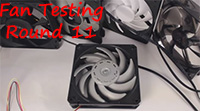Welcome to the third in my series of 2x120mm under $150 value series kit reviews, the Larkooler iSkyWater 300. Larkooler is a fairly new brand to me as I haven’t had a chance to review any of their parts or pieces individually. Unlike the XSPC kit which left me running to the grocery store to get distilled water, this kit is complete with fluid and everything you need to put your system together. Also unlike the sealed AIO units such as the Corsair H100i which are sealed and not intended for expansion, the Larkooler iSkyWater 300 is DIY and there are VGA block and Ram block accessories intend to go with this kit for expansion possibilities. Also unlike the sealed kits where tubing is already connected and sealed, the Larkooler kit comes with external radiator mounting brackets and designed to be mounted internally or externally depending on your case needs. At $129.95, that makes this kit extremely low-cost, compatible with most cases if external mounting is desired, and expandable which we all like. We’ll put it to the test in this next review and see how it stacks up to similarly prices 2x120mm radiator sub $150 water cooling kits.
Before going to far, I would like to give special thanks to Mark from FrozenCPU for sponsoring this kit, they are your one-stop-shop for all PC modification supplies!

FrozenCPU Product Information
Product Description
Larkooler is a new generation cooling system for desktop computers. It is designed with the best cooling solution for the most important component of your PC, the CPU. This kit includes everything you need to get started. A pure copper block for maximum heat absorption. One 24cm radiator with two 120x25mm fans. Last is the tubing and cooling fluid. The VGA, Chipset and Mosfet blocks can be added to upgrade performance. The iSkyWater 300 provides a reliable low noise, high performance liquid cooling system. Literally every EVERYTHING you need is here in this kit!
Note: Radiator color is now black.
Features
- Most Cost-Effective CPU Liquid Cooling
- Very High C/P
- Supports INTEL LGA775/LGA1156/LGA1366/LGA2011
- Supports AMD Socket 754/939/940/AM2/AM2+/AM3
- 3D Micro-Structure Thermal solution adapted, outstanding heat dispersion under very low water flow.
- Supports most CPU like Intel i7& AMD Phenom II processors.
- The universal type strengthened backplate not only prevents MB distortion but also has high compatibility for all kinds of MBs.
- Easy installation due to 2-way tubing design which also enables upgrade to series connection of more water blocks.
- Highly polished base to ensure excellent surface contact with heat source.
- Fitting with refrigeration-and- air-conditioning-class structures provides high performance heat dispersing at low noise.
- Easy installation design and back mounting bracket let DIYers enjoy DIY.
- Specially designed bolts and nuts to prevent tube’s looseness and coolant leakage.
- Pump with refrigeration-and- air-conditioning-class structures provides low-water warning.
- Steady and silent working.
- Easy installation design brings more fun to DIYers.
- Specially designed bolts and nuts to prevent tube’s looseness and coolant leakage.
- Thread upgradable to be compatible with G1/4″ water cooling system
Specifications
CPU Water Block Dimension: D45xH29mm Weight: 180g Material: Pure Copper Pump Dimension: 100x70x82mm Rated Voltage & Current: DC12V/0.41A Weight: 330g Flow Rate: 72L/Hour Max. Water Lift: 200cm Radiator Dimension: 35x124x302mm Material: Copper tubes with aluminum fins Fan Speed: MAX 1800 RPM Fan Connector: 3 pin Fan Max. Air Flow: 62.7CFM Noise: 31.1dBA Life Expectancy: 50000 hrs at 25°C Tank Capacity: 150ml Coolant Main Composition: water & propylene glycol Volume: 250 ml Anti-freezing: -5°C Tube Dimension: OD8mm / ID 6mm Length: 200cm Material: PU Max Operation Temperature: 50°C Supports Intel: LGA775/LGA1366/LGA1156/LGA2011 AMD Socket: 754/939/940
Description/Spec Thoughts
One of my initial worries was seeing the aluminum fins thinking the radiator was aluminum, but it is NOT. The radiator uses round copper tubes with aluminum fins pressed over the round tubes, but the critical part contacting water is all copper. The block is also copper, so no worries about mixed metals, the kit is all good copper/brass metals.
Pump
The pump has a good 2m head static pressure rating, however the 72LPH max flow rating converts to .26GPM, so it’s more of a high pressure but very low flow pump. At the rated .41Amps that makes this about a 5W max pump which is a good amount of power compared to AIO sealed units which are down in the 1-2W range. We’ll see how it does in operation. I did find this searching the net:
One more pretty cool feature in looking over the box, is the pump has a “Low Water Level” warning function, and of course you could easily connect multiple pumps in series as they show below:
Fitting Compatibility
The other “Mostly” good feature is the G 1/4″ threading compatibility. This is great for the block and radiator which all include the standard female G1/4″ threading so you can use your own barbs, BUT…the pump does not. The pump has male cast 6mm ID barbs with compression fitting threads which are intended to fit 6mmID x 8mmOD tubing. So you are a bit stuck with the smaller tubing size and fitting style with the pump, but the rest of the system could utilize custom fittings.
CPU Block
Digging further on the CPU block I actually found “SCIENCE”!! This does show how the block is very capable at very low flow rates:

Source: http://www.larkooler.tw/CWB-10.htm
For Reference: 1000ml/min = 0.26 GPM
Case Compatibility
Also not really advertised in the specs, but something I really like is their external radiator mounting brackets. For users who have a small case that may not support a 240 radiator, they give you nice brackets that could be used to install a radiator externally to the back or top of the case which increases case compatibility significantly.

Source: http://www.larkooler.tw/RX-240-radiator.htm
Warranty/Lifespan
The radiator has a 50,000 hour lifespan. The Warranty period at 1 year is also a bit less than the H220 3 year warranty or Corsair’s H100i 5 year warranty.
That’s not to say warranty matches actual service life, I just prefer seeing pump MTBF ratings and warranty for a few years.
Overall, quite a bit here to review and some promising specs and features for such a value priced kit. We’ll start next with the unboxing.








You must be logged in to post a comment.